
The Legend of Zelda is an action-adventure game franchise created by the Japanese game designers Shigeru Miyamoto and Takashi Tezuka. It is primarily developed and published by Nintendo, although some portable installments and re-releases have been outsourced to Flagship, Vanpool, and Grezzo. The gameplay incorporates action-adventure and elements of action RPG games.
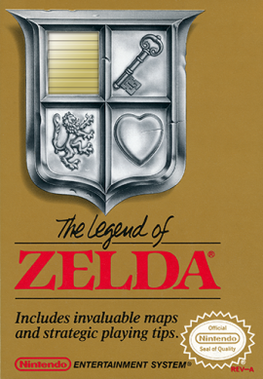
The Legend of Zelda, originally released in Japan as The Hyrule Fantasy: Zelda no Densetsu, is an action-adventure game developed and published by Nintendo. The first game of The Legend of Zelda series, it is set in the fantasy land of Hyrule and centers on an elf-like boy named Link, who aims to collect the eight fragments of the Triforce of Wisdom in order to rescue Princess Zelda from Ganon. The player controls Link from a top-down perspective and navigates throughout the overworld and dungeons, collecting weapons, defeating enemies and uncovering secrets along the way.

The Legend of Zelda: A Link to the Past is an action-adventure game developed and published by Nintendo for the Super Nintendo Entertainment System. It is the third game in The Legend of Zelda series and was released in 1991 in Japan and 1992 in North America and Europe.

The Legend of Zelda: Majora's Mask is a 2000 action-adventure game developed and published by Nintendo for the Nintendo 64. It was the second The Legend of Zelda game to use 3D graphics, following Ocarina of Time (1998). Designed by a creative team led by Eiji Aonuma, Yoshiaki Koizumi, and Shigeru Miyamoto, Majora's Mask was completed in less than two years. It featured enhanced graphics and several gameplay changes, but reused a number of elements and character models, which the game's creators called a creative decision made necessary by time constraints.

The Legend of Zelda: The Wind Waker is an action-adventure game developed and published by Nintendo for the GameCube. An installment in The Legend of Zelda series, it was released in Japan on December 13, 2002, in North America on March 24, 2003, and in Europe on May 2, 2003.

The Legend of Zelda: Oracle of Seasons and The Legend of Zelda: Oracle of Ages are two 2001 action-adventure games in The Legend of Zelda series, developed by Flagship and published by Nintendo for the Game Boy Color.
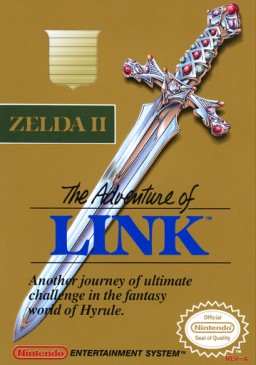
Zelda II: The Adventure of Link is an action role-playing video game with platforming elements developed and published by Nintendo. It is the second installment in the Legend of Zelda series and was released in Japan for the Famicom Disk System on January 14, 1987—less than one year after the Japanese release and seven months before the North American release of the original The Legend of Zelda. Zelda II was released in North America and the PAL region for the Nintendo Entertainment System in late 1988, almost two years after its initial release in Japan.
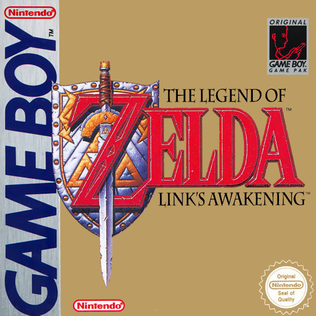
The Legend of Zelda: Link's Awakening is a 1993 action-adventure game developed and published by Nintendo for the Game Boy. It is the first installment in The Legend of Zelda series for a handheld game console. Link's Awakening is one of the few Zelda games not to take place in the land of Hyrule, and it does not feature Princess Zelda or the Triforce relic. Instead, the protagonist Link begins the game stranded on Koholint Island, a place guarded by a whale-like deity called the Wind Fish. Assuming the role of Link, the player fights monsters and solves puzzles while searching for eight musical instruments that will awaken the sleeping Wind Fish and allow him to escape from the island.
Ninja Gaiden is a media franchise based on action video games by Tecmo featuring the ninja Ryu Hayabusa as its protagonist. The series was originally known as Ninja Ryukenden in Japan. The word "gaiden" in the North American Ninja Gaiden title means "side story" in Japanese. The original arcade version, first two Nintendo Entertainment System games and Game Boy game were released as Shadow Warriors in PAL regions. As of 2008, the series has shipped over 7.7 million copies.

Raid on Bungeling Bay is a shoot 'em up video game developed by Will Wright and published by Broderbund for the Commodore 64 in 1984. It was the first video game designed by Will Wright. The Commodore 64 version was published in the UK by Ariolasoft. The game inspired Wright to develop SimCity in 1989.

The Battle of Olympus is a 1988 action role-playing video game for the Nintendo Entertainment System. It was released in North America in 1990, in Europe in 1991. A port for the Game Boy was also released.
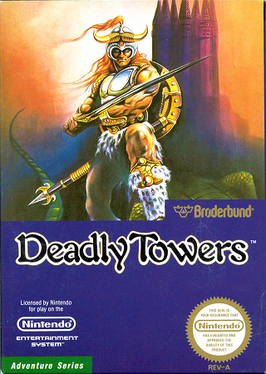
Deadly Towers is an action role-playing game co-developed by Lenar and Tamtex for Irem as a software title for the Nintendo Entertainment System (NES). It was released in Japan on December 15, 1986, and in North America in September of the following year.
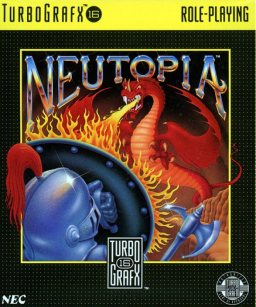
Neutopia is an overhead action-adventure video game developed by Hudson Soft. It was released by Hudson for the PC Engine in Japan on November 17, 1989. It was then released by NEC for the TurboGrafx-16 in North America in 1990. It was re-released for the Virtual Console service worldwide for the Wii in 2007; it was re-released for the PlayStation Network in Japan in 2010 and in North America in 2011. It was re-released for the Wii U on April 16, 2014 in Japan, and in USA and Europe in 2017. The game takes place in the land of Neutopia, where the evil demon Dirth has captured Princess Aurora and has stolen the eight ancient medallions which contain the wisdom and power necessary to maintain peace and prosperity throughout the land. It is up to the protagonist Jazeta to retrieve the eight medallions, defeat Dirth, rescue Princess Aurora, and save the land and its people.
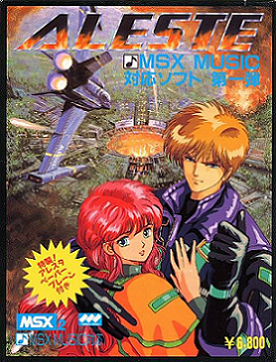
Aleste (アレスタ) is a vertically scrolling shooter developed by Compile, originally published by Sega in 1988 for the Master System and then by CP Communications for the MSX2. The Master System version was released outside Japan as Power Strike. The game spawned the Aleste and Power Strike franchises.
Compile Corporation was a Japanese video game developer, most notable for having developed the Puyo Puyo series, a franchise derived from the Madō Monogatari series. On 6 November 2003, the company shut down amid bankruptcy. As a result, key staff moved to Compile Heart, the company's spiritual successor, whereas shoot-'em-up staff moved to MileStone Inc.
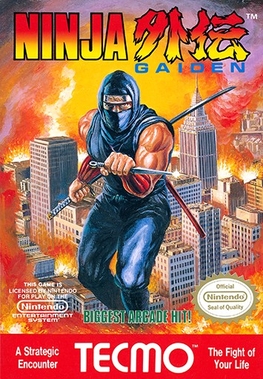
Ninja Gaiden, released in Japan as Ninja Ryūkenden and as Shadow Warriors in Europe, is an action-platform video game developed and published by Tecmo for the Nintendo Entertainment System. Its development and release coincided with the beat 'em up arcade version of the same name. It was released in December 1988 in Japan, in March 1989 in North America, and in August 1991 in Europe. It has been ported to several other platforms, including the PC Engine, the Super NES, and mobile phones.

Legacy of the Wizard, originally released in Japan as Dragon Slayer IV: Drasle Family, is a fantasy-themed action role-playing platform game released for the MSX, MSX2 and Famicom in Japan and for the Nintendo Entertainment System in the United States. Legacy of the Wizard is an installment in Falcom's Dragon Slayer series, and one of only five Dragon Slayer games that were localized outside Japan. The game was an early example of an open-world, non-linear action RPG, combining action-RPG gameplay with what would later be called "Metroidvania"-style action-adventure elements.

Gunhed, known as Blazing Lazers in North America, is a vertically scrolling shooter game by Hudson Soft and Compile, based on the Japanese film Gunhed. The title was released in 1989, for the PC Engine in Japan and re-skinned for the TurboGrafx-16 in North America, with Gunhed unofficially imported for the PC Engine in Europe. In the game, a fictional galaxy is under attack by an enemy space armada called the Dark Squadron, and this galaxy's only chance for survival is the Gunhed Advanced Star Fighter, who must destroy the Dark Squadron and its Super Weapons. The gameplay features fast vertical scrolling and a wide array of weapons for the player to use.
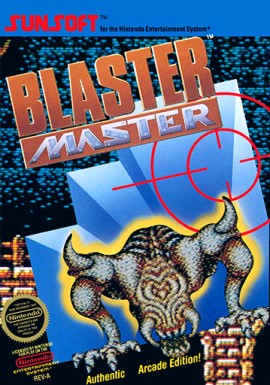
Blaster Master is a platform and run and gun video game released by Sunsoft for the Nintendo Entertainment System. It is a localized version of a Japanese Famicom game titled Chō Wakusei Senki Metafight, which was released on June 17, 1988. The game was released in North America in November 1988 and in Europe on April 25, 1991. The game is the first in the Blaster Master series, and it spawned two spin-off games as well as two sequels.
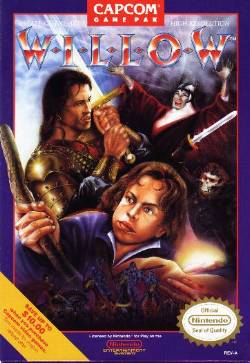
Willow is a 1989 2D action role-playing game developed and published by Capcom for the Nintendo Entertainment System. It is loosely based on the 1988 film of the same name and is the second title Capcom released based on Willow that year, the first being an unrelated side scrolling arcade game. The version of Willow released for the Nintendo Entertainment System and the Famicom is an adventure game in the vein of The Legend of Zelda.




















